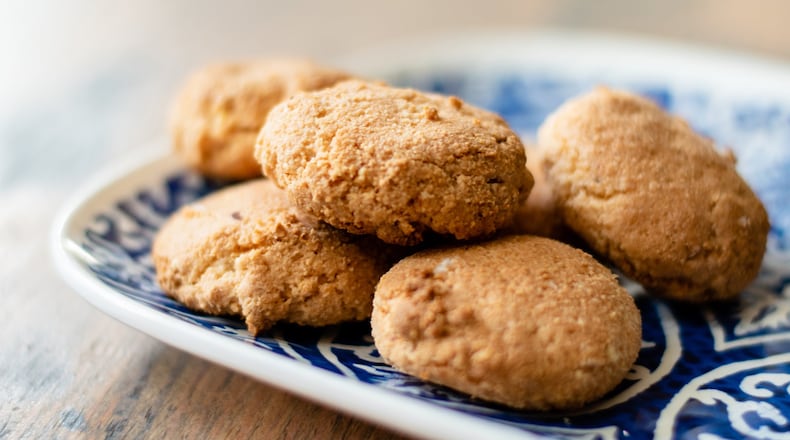Boterkoek is neither a cookie, nor a cake nor a pie. The Dutch treat is a dense, sweet pastry made from a simple mix of butter, sugar and flour, kneaded into a firm dough, pressed into a baking pan and cooked to a buttery golden delight. “Boter” means butter and that sums it up pretty well.
A boterkoek recipe published in the November/December issue of Milk Street Magazine reads more like the preparation for a classic cake. It calls for soft butter, beaten until fluffy and pale, for eggs beaten into the mixture, and for adding flour last. I was puzzled when I read in the test instructions: “Don’t underbeat the butter and sugar mixture. It needs to be very light and fluffy…or it will bake up too dense.” What? Creamy density is what boterkoek is all about!
The Milk Street boterkoek was quite good, but it didn’t remind me of any of the boterkoek I had ever tasted. It wasn’t as yellow, dense, buttery or decadent as I think it should be. I did like the crumbly crust, but the center did not have a fudgy quality. It made me long for the boterkoek my mother used to make for every birthday party, for the boterkoek I’ve eaten at market stalls, in cafes chic and shabby, or straight from thin aluminum containers purchased at the supermarket. I have most likely eaten my weight in boterkoek.
The late food historian Johannes van Dam dedicates a chapter to boterkoek in his encyclopedic work “De Dikke Van Dam” (The title translates to “The Fat Van Dam,” and refers to the most prestigious Dutch dictionary and to Van Dam’s not-too-slender physique). Van Dam’s research reveals that boterkoek appears for the first time in Dutch cookbooks in the 1930s, and that no neighboring countries can lay any claims on its origins. A great boterkoek, according to Van Dam, is fairly thick, has a soft, buttery center and a slightly crisp crust, and does not contain eggs or other rising agents in the dough. He advises not to mess with the ratio of flour, butter and sugar (38 percent flour, 35 percent butter and 27 percent sugar); too much sugar and the pastry will be tough, too much flour and the pie will be dry and mealy.
It was inevitable that my boterkoek quest threw me back to work breaks in the Netherlands, ubiquitous interludes where people get together for coffee (in the morning) or tea (in the afternoon), and possibly the epitome of the Dutch ur-concept of “gezellig.” Gezellig is the Dutch variety of the Scandinavian “hygge,” and life in the Netherlands is unthinkable without it. Countless things are considered to be “gezellig.” We use it all day long to express our pleasure in finding a sense of well- being, good taste, inclusiveness and coziness.
Our tradition of coffee breaks perhaps explains why the Dutch have such an inordinate number of cookies in their culinary repertoire. Many cookies are closely linked to one province or region, or even just one town. Considering Holland’s size (is one-fourth the size of the state of Georgia), this is pretty astounding.
In my family, it was customary to take three coffee breaks: at 10 a.m., 3 p.m. and at 8 p.m., when my father would turn on the TV for the daily news. One of his favorite treats was bitterkoekjes (literally “bitter cookies”), a slightly larger spin on Italian amaretti, but less crunchy and deliciously chewy in the center. They’re very easy to prepare: ground almonds are combined with sugar and egg whites, formed into balls, pressed down a bit and swiftly baked. Almond essence gives them a pleasant, subtly bitter taste. It also safely substitutes for raw bitter almonds that were used in small amounts in the past.
Bitterkoekjes used to be offered at weddings, as their flavors – the sweetness of the sugar and the bitterness of the almonds – symbolized all that marriage might offer. Bitterkoekjes are so beloved in Holland that they flavor cakes and puddings as well, and you’ll find pre-packaged mixes for both in many grocery stores.
Another treat intricately linked to my childhood are Dutch pancakes called pannenkoeken. I dare say there is no Dutch household where pancakes aren’t cooked on a regular basis. Usually they are served at lunch, not breakfast, and they resemble a French crepe more than an American pancake.
Fairly thin, large and not sweetened, pannenkoeken lend themselves to all manner of sweet and savory toppings. The authentic way to eat a Dutch pancake is to spread it with a filling of your choice and roll the pancake around it. My son eats them exclusively with Nutella. My mother craved hers with beef ragout. My daughter loves hers plain.
I am proud to say that Dutch pancakes have found a firm foothold in certain homes in my Decatur neighborhood. Friends of my children have eaten stacks of pannenkoeken after sleepovers in our house, and these pancakes were a ubiquitous try-it dish at the summer cooking camps I used to organize. To this day, I still get requests for the recipe. Once you try them, you’ll know why.
Boterkoek (Dutch Butter Pie)
Boterkoek is usually made with caster sugar, a finely granulated sugar that can be harder to find than typical granulated sugar. Also called “baker’s sugar” or “superfine sugar,” caster sugar has a structure between granulated sugar and powdered sugar. It is ideal for certain types of baked goods because granulated sugar doesn’t always “melt” completely and leaves a grainy texture. You can easily make your own caster sugar by processing granulated sugar in a food processor, as directed in this recipe.
<<See the full recipe on mobile here
<<See the full recipe on mobile here
Pannenkoeken (Dutch Pancakes)
Melted butter in the dough makes these pancakes irresistible. As soon as the batter hits the pan, tilt the pan quickly in all directions so the batter spreads evenly over the bottom. The first pancake is usually a bit of a failure, even for very experienced pancake-makers. From there on, it goes rapidly uphill. Flipping the pancakes is easiest with an extra-long flexible spatula, preferably metal.
<<See the full recipe on mobile here
b
About the Author
The Latest
Featured




